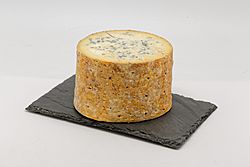Fourme de Montbrison facts for kids
Quick facts for kids Fourme de Montbrison |
|
|---|---|
 |
|
| Country of origin | France |
| Region, town | Montbrison |
| Source of milk | Cows |
| Pasteurised | Yes (coopérative); no (artisanal) |
| Texture | Blue cheese |
| Aging time | 4-8 weeks |
| Certification | French AOC 1972, EU PDO 2010 |
| Named after | Lua error in Module:Wikidata at line 70: attempt to index field 'wikibase' (a nil value). |
Fourme de Montbrison is a special kind of cheese made from cow's milk. It comes from the Rhône-Alpes and Auvergne regions in southern France. This cheese gets its name from the town of Montbrison.
The word fourme comes from an old Latin word, forma. This word means "shape." It's the same root word that the French word for cheese, fromage, comes from.
This cheese is made in tall, round blocks. Each block weighs about 1.5 to 2 kilograms (around 3 to 4.5 pounds). The blocks are 13 centimeters (about 5 inches) wide and 19 centimeters (about 7.5 inches) tall. However, you will often find it sold in shops as shorter, round slices.
Fourme de Montbrison has a unique orange-brown rind (the outer skin). Inside, the cheese is creamy-colored with light blue mould streaks. It received a special certification called AOC in 1972. This certification ensures that the cheese is made in a specific way and place. It was first certified along with a similar cheese called Fourme d'Ambert. But in 2002, both cheeses got their own separate AOC status. This was because their making processes were different enough to be recognized on their own.
This cheese has a slightly earthy smell. It is quite mild for a blue cheese and has a dry taste.
Contents
How Fourme de Montbrison is Made
Making Fourme de Montbrison is a careful process. First, the cheese curd (the solid part of milk) is salted. Then, it is placed into a special mould to give it shape.
Shaping and Turning the Cheese
After being shaped, the cheese is taken out of the mould. It is then placed on racks made from spruce wood. Workers turn the cheese by hand. They turn it 90 degrees at a time, over a period of 12 hours. This helps the cheese to drain and form properly.
Adding the Blue Mould
Next, tiny spores of penicillium roqueforti are injected into the cheese. These are the special moulds that give blue cheese its unique color and flavor. Later, air is also injected into the cheese. This creates small pockets inside, which helps the mould spores grow and spread.
Aging the Cheese
The cheese must be aged for at least 28 days. But usually, it is left to age for about 8 weeks. This aging process gives the cheese its full flavor and texture. About 20 to 25 liters (around 5 to 6.5 gallons) of milk are used to make each cheese.
Where it's Made
By law, Fourme de Montbrison can only be made in certain areas. These areas are 33 specific towns (called communes) in the Monts du Forez mountains. These towns are located in the Puy-de-Dôme and Loire departments of France.
Milk and Production
The finished cheese must contain at least 50% fat. Most of this cheese is made using pasteurized milk. This means the milk has been heated to kill any harmful bacteria. However, some smaller, traditional cheesemakers (called artisanal makers) use unpasteurized milk. In 2005, about 495 tons of Fourme de Montbrison were produced in total.
See also
- In Spanish: Fourme de Montbrison para niños

